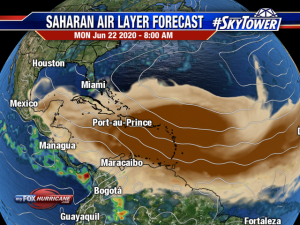The Saharan Air Layer – Need To Know
June 24, 2020
What is the Saharan Air Layer?
A huge cloud of dust known as the Saharan Air Layer (SAL) has traveled from the Saharan Desert and is now covering the Caribbean in a thick haze. The cloud of dust, the largest in 50 to 60 years to reach the Caribbean Sea, is expected to travel into the Gulf of Mexico and parts of the U.S. later this week.

SAL is a mass of very dry, dusty air that forms over the Sahara Desert during the late spring, summer, and early fall, and moves over the tropical North Atlantic every three to five days. SAL outbreaks usually occupy a 2 to a 2.5-mile-thick layer of the atmosphere with the base starting about 1 mile above the surface.
SAL activity usually ramps up in mid-June, peaks from late June to mid-August, and begins to rapidly subside after mid-August. Saharan dust takes a 5,000-mile-long journey as far west as the Caribbean Sea, Florida, and the Gulf of Mexico each year and covers vast areas of the Atlantic. However, it is usually not as thick as the current conditions over the Caribbean.
How Does the Dust Affect You?
If you have asthma, you could be affected the most. People with allergy issues also suffer. Symptoms can include trouble breathing, asthma attacks, incessant sneezing, swelling of the throat and eyes, coughing, watery and itchy eyes, runny and stuffy nose.
Those who aren’t usually susceptible to allergy issues can also experience these symptoms, especially when there’s a higher concentration of dust in the atmosphere.
The lucky ones, who may not suffer health-related effects, can experience inconvenience in other ways. The dust tends to infiltrate clean home spaces and is most popular on vehicles left in its path. It’s still advised that these spaces and surfaces are cleaned as often as possible, as leaving the dust to gather only increases the risk of health-related challenges.
How to Treat the Symptoms
For those who suffer more complicated respiratory ailments, it’s advised that you keep the required medication on your person at all times. Speak to your doctor to decide whether more aggressive treatment would be necessary or to set up a plan of action in case of an emergency.
The Good News
The warmth, dryness, and strong winds associated with the SAL have been shown to suppress tropical cyclone formation and intensification, and the dust-laden air also produces spectacular sunrises and sunsets.